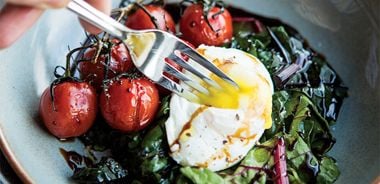Poached Eggs with Balsamic Glaze, Swiss Chard, and Roasted Tomatoes

Simple poached eggs are lent an elegant cachet by the addition of a flavourful balsamic reduction and roasted cherry tomatoes. Resting on a nutritious bed of Swiss chard, this über healthy meal is easy to prepare and makes the perfect quick lunch or dinner.
1/3 cup (80 mL) balsamic vinegar
1 Tbsp (15 mL) coconut palm sugar or honey
20 cherry tomatoes
1 Tbsp (15 mL) extra-virgin olive oil
1 bunch Swiss chard (about 4 cups/1 L)
Dash of white vinegar
4 large free-range eggs
Salt and pepper, to taste
Preheat oven to 350 F (180 C). In small saucepan over medium heat, bring balsamic vinegar and sugar to a boil. Reduce heat and allow to simmer until mixture becomes syrupy. Remove from heat and allow to cool.
Meanwhile, place cherry tomatoes in ovenproof dish and drizzle with olive oil. Place in oven and roast for about 10 minutes—or just until tomatoes begin to collapse.
While tomatoes are roasting, wash and tear Swiss chard. Steam chard in steamer until just softened, about 3 minutes. Remove from heat and set pan aside until ready to assemble the dish.
As chard cooks, prepare eggs by bringing large saucepan filled with water to a gentle simmer. Add dash of white vinegar to water and stir with spoon to create a swirl. Carefully break 2 eggs into water and cook for about 3 minutes. Remove with slotted spoon and repeat this process with remaining 2 eggs.
When eggs are done, divide chard onto 4 plates. Surround chard with 5 roasted tomatoes on each plate. Top chard with poached egg and drizzle each plate with cooled balsamic reduction. Season with salt and pepper to taste. Serve with crusty bread and slices of mozzarella for a complete meal.
Serves 4.
Each serving contains: 159 calories; 8 g protein; 9 g total fat (2 g sat. fat, 0 g trans fat); 12 g total carbohydrates (9 g sugars, 2 g fibre); 191 mg sodium
source: "Easter Eggs-travaganza", alive #390, April 2015




